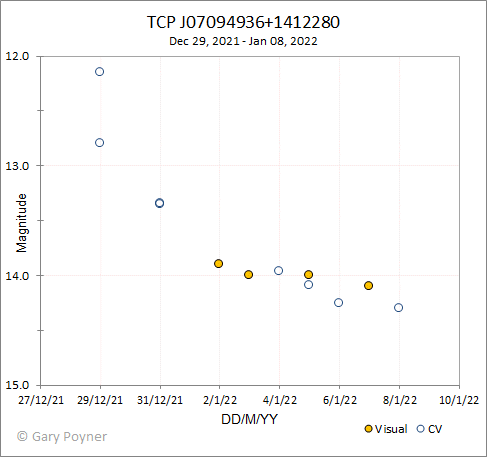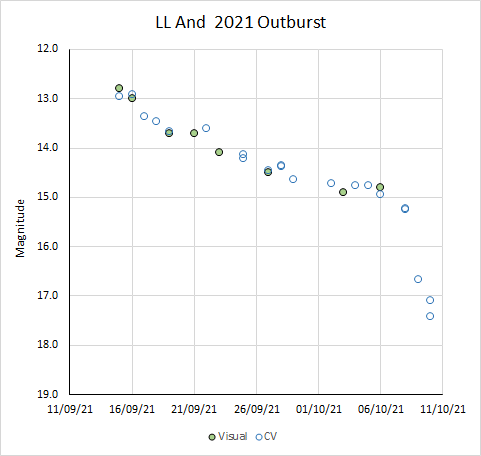Forum Replies Created
-
AuthorPosts
-
28 July 2022 at 11:22 am in reply to: Talk about Irish Astronomer: John Birmingham (1816–1884) #611637
 Gary PoynerParticipant
Gary PoynerParticipantThank you for sharing the link Ronan. I’ve searched far and wide for years for a likeness of him without success.
Gary
 Gary PoynerParticipant
Gary PoynerParticipantNot a chance from North Brum (even if clear), but SLOOH C2 captured an image on June 8…
June 8.052 9.461CV (0.002)
June 8.053 9.468TG (0.008)So it’s already nearly two mags fainter than it’s peak on June 7 (AAVSO light curve).
Gary
 Gary PoynerParticipant
Gary PoynerParticipantThanks for mentioning it Nick. I’m looking forward to watching the meeting on YouTube over the weekend.
V482 Cyg seems to have paused in it’s decline at the moment (according to V, mv values), but it’s worth keeping an eye on over the next few weeks to see what happens.
I assume it will get redder as it fades, but it’s been so long since it did anything that there are only visual data covering the fades. Looking at the AID, the first V measures occured in 2000 and after.
Gary
 Gary PoynerParticipant
Gary PoynerParticipantCloudy here in Birmingham last night/this morning, but clear at SLOOH Tenerife…
V482 Cyg May 24.149UT 11.84CV
V482 Cyg May 24.149UT 12.02TGObservations should be made every night if possible please, and reported to the BAAVSS as soon as possible. There is no way of knowing how deep V482 Cyg will go if it continues to fade, but observers should be careful of a close 13.7 mag star 7″ to the SW if V482 Cyg approaches mag 14.0
Gary
 Gary PoynerParticipant
Gary PoynerParticipantLooks like a false alarm – which is very disappointing. Thank you all for taking the time to check. Really appreciated.
Gary
 Gary PoynerParticipant
Gary PoynerParticipantI obtained an unfiltered CCD image from SLOOH Chile on May 3.006UT and measured it at 12.540CV +/- 0.004 using a nearby A2 star. There currently isn’t a sequence with the AAVSO chart, although I suspect that will appear before too long.
Gary
 Gary PoynerParticipant
Gary PoynerParticipantI had it at 12.5 visual on March 14.085 UT. It was a tad brighter in April 2020 at 12 4, and then 11.9 in April 2013 – the brightest ‘outburst’ for a number of years. I have a light curve here… https://garypoyner.wix.com/variablestars/markarian-421
Gary
-
This reply was modified 3 years, 9 months ago by
 Gary Poyner.
Gary Poyner.
 Gary PoynerParticipant
Gary PoynerParticipantI first met Ron at the Winchester weekend of 1978. I was in awe of his ‘astro-photography’, and can still remember those stunning photo’s of M42 which he used to display in the reception area of King Alfreds College. He turned up to a few VS meetings over the years, along with those held by the Deep Sky Section. It was always a pleasure to see him again and have a chat. His search for perfection in his telescopes was always a source of amusement to me (and others I have to say), and I would often ask him what telescope he had taken apart since we last met. Each year that he attened Winchester, he would invite me to break my journey home to Birmingham to visit him and see his observatory set-up. An offer I never did take up, and one which I truly regret now. My thoughts are with Pat at this sad time.
Gary
-
This reply was modified 3 years, 10 months ago by
 Gary Poyner.
Gary Poyner.
 Gary PoynerParticipant
Gary PoynerParticipantI can’t say I like the new site very much. For me it’s too ‘loud’ and crowded even on my large desktop monitor, but especially so on a laptop and phone. Much preferred the old layout.
I do appreciate all the hard work that’s gone into it though, but I’m not a fan of change for changes sake (I do realise that the web site needed to be upgraded behind the scenes though, so well done to all involved for that).
Recent forum posts definitely need to be put back on the home page please! That was always my first stop when I visited the old site, and as Nick says above, this is probably true for a lot of other visitors too.
Gary
 Gary PoynerParticipant
Gary PoynerParticipantThis Nova (V606 Vul) is brightening once again. Looking at the VSS database, it can be seen that the Nova has been slowly rising from mid December (Mag 18.9V on Dec 6), through January where Nick James was able to follow it to mag 14.76CG by Jan 31. I’ve just measured an image taken by SLOOH this morning (Feb 23) at mag 14.6C.
If you can get to the field at this time of year, please report your observations to the VSS.
Gary
 Gary PoynerParticipant
Gary PoynerParticipantI remember chatting with Ian about his early days with PEP over lunch in some bar in some city years ago, and he did indeed have problems with his home built kit, but it’s been so long ago that we had this conversation that I can’t recall details. When CCD’s became available, Ian would have packed the PEP away (working or not) and gone with the new tech as soon as he was able, to that I’m sure.
David. I’ll be happy to take it off your hands to keep it within the VSS at least. I’ll drop you an email about it.
Gary
 Gary PoynerParticipant
Gary PoynerParticipantEleven days into the outburst, this dwarf nova of the relatively rare type UGWZ is still fairly bright in the evening sky after fading by just over two magnitudes since discovery, and remains worthy of continued observation – visual, single image or time series.
My own light curve consiting of visual observations from Birmingham and CCD images from COAST and SLOOH is shown below.

Gary
 Gary PoynerParticipant
Gary PoynerParticipantHappy New Year!
Observing statistics for 2021 (2020 in parentheses)
Gary Poyner (Birmingham)
Not a bad first half of the year, but from August the majority of the time was taken with dodging cloud and observing in cloud breaks. Only 11 totally clear nights in the whole year (clear from dusk to dawn), and these were all in the first half of 2021. Dismal!
2021
Clear nights (less than 50% cloud) 19 (44)
Partially clear nights (50% or more cloud) 100 (95)
Totally cloudy nights 246.
Total observable nights 119 (139) with 82 (67) of these nights having Moonlight interference. I made observations on all 119 nights.Total hours at the telescope 227.7 (296.9) hrs
Best month April with 16 nights – 12 partially clear and 4 clear (May. 24)
Worst month December with 3 nights – 2 partially clear and one clear. (Feb. 6)Birmingham Met office gave incorrect information on cloud cover for 73 nights during 2021 (73)
Total visual VS observations for 2021 is 8,201 (10,717) a decrease of 2516 on 2020. CCD single measures using remote telescopes COAST, SLOOH and the AAVSO SRO-50 are 3,527 (1,909), an increase of 1618 on 2020.
Gary
 Gary PoynerParticipant
Gary PoynerParticipantAfter nine months of ups and downs, V1405 Cas has finally broken through the mag 10 barrier – last night (Dec 19) 10.47TG. That’s a 0.7 mag drop in 24h.
Gary
 Gary PoynerParticipant
Gary PoynerParticipantNot a hope of the cloud shifting here in Birmingham, but a SLOOH measure from last night has this new DN as…
Nov 30.833 UT 12.59C
Gary
 Gary PoynerParticipant
Gary PoynerParticipantLatest datapoint in AAVSO is 16.9V on Nov 11. That’s a 4.5 mag drop in just 5 days. Pretty quick. V1391 Cas took twice as long to drop by a similar magnitude ~ 10 days.
Gary
 Gary PoynerParticipant
Gary PoynerParticipantI echo all the sentiments here. An excellent meeting, top quality video, sound levels perfect and very well presented.
Well done to all involved.
Gary
 Gary PoynerParticipant
Gary PoynerParticipantI’ve not seen it either due to the weather, and am keen to do so. Once faded, there is a chance of a rebrightening(s). It doesn’t have to be a UGWZ to do this, as I have seen UGSU’s show a rebrightening (In 1996 I once observed a normal outburst in UV Per trigger a superoutburst followed by one rebrightening), but not more than one as UGWZ’s are prone to do.
Gary
 Gary PoynerParticipant
Gary PoynerParticipantVSNET-alert 26333 today announced that early superhumps with a period of 0.05404(4) d and amplitude of 0.055m had been detected (by Tonny Vanmunster), and that the object is a UGWZ type star. I must say that to me it seems a bit early to give this classification as definite, so probably wait for more data before we all go down the pub to celebrate. Taichi Kato isn’t often wrong in these matters though.
There is a chart and a very limited sequence (two stars so far) available for download from the AAVSO here, using the designation XM78HT or AT 2021ABOG.
Latest magnitude in the AAVSO DB is Vanmunsters showing 13.9-14.0C. (Oct 18.2 UT)
Gary
 Gary PoynerParticipant
Gary PoynerParticipantHere is my light curve of the outburst so far. Last night (Oct 11) it was fainter then 17.9CV. LL And dropped just over two magnitudes in two days.
I’ll certainly continue to monitor for any rebrightening(s).
Gary

-
This reply was modified 3 years, 9 months ago by
-
AuthorPosts
